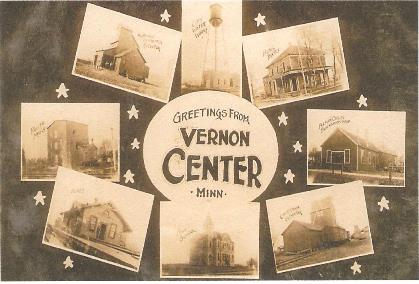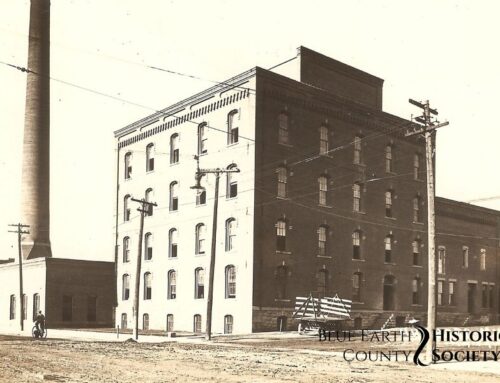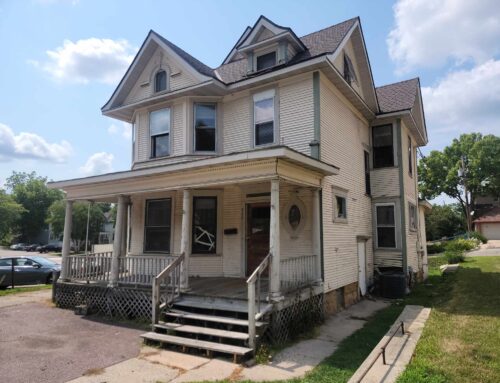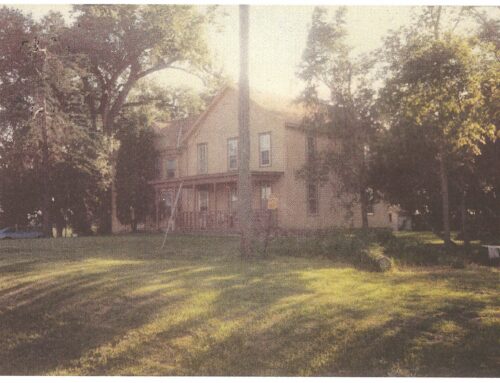Determining the look of a main street one hundred years ago, fifty years ago, or even ten years ago is difficult to ascertain as businesses are constantly opening and closing, moving locations, or even being destroyed, usually by fire. For example, the Community Bank in Amboy. It was chartered in 1906 as 1st National Bank. In 1910, it merged with German State Bank. Located mid-block on the north side of Maine Street, the building was destroyed in the fire of 1940. However, in 1925, the bank moved to the northeast end of the block, at the corner of 2nd Street and Maine. 1933 brought a name change to the Security National Bank of Amboy. It is presently the Amboy branch of Community Bank and is located in a new building that still sits on the corner of 2nd and Maine, but now the southeast corner. The 1925 building still stands, bearing the name First National Bank across its front but selling antiques.
It’s undetermined which was the primary street in Garden City. The town formed around the flour mills located on the Watanwon River. A bridge crossed the river, carrying the major north/south road. Another bridge carried the east/west road. Both bridges were in place in 1895 when plat maps were printed. A store began in a tent in 1856, becoming more permanent the following year. It’s not clear on which side of the river that store stood, but by 1859; there was a store and public house on the west side of the river. By 1861, at least three stores were located on the east side of the river. The first hotel, The Garden City House, began in 1857, and the Watonwan House became the second hotel in 1873.
The book “The History of Blue Earth County” records that in 1868, there were three grist mills, four general stores, two drug and grocery stores, one hardware store, one hotel, a wagon shop, a harness shop, a shoe store, a tailor shop, a blacksmith shop, a cabinet shop, one newspaper, two public halls, a two-story schoolhouse, and three churches.
When the railroad arrived in 1877, it ran along the hill above the west side of Garden City. Unlike other towns like Rapidan, Amboy, or Vernon Center, Garden City did not relocate to be closer to the depot. This decision and the town’s ability to adapt to the changing landscape are testaments to its resilience and unique character.
By 1900, three blacksmith shops were in operation: a butcher’s shop, a bakery, three hardware stores, a post office, a harness shop, three barber shops, two hotels, several small grocery stores, and mills. By the mid-century, few of these businesses had remained. One bridge was gone. Highway 169 came into town on Main Street and turned to leave town on Washington Street.
Today, one can guess where two churches were located, both on Washington Street and the east-west road, as their buildings are still in use. The school remains in the same location. The possible remains of one mill sits on the east side of the river. The post office, which was once a bank, sits on Main Street, the north-south street, as does the empty building that was once Crane’s Hardware.
One of the principal businesses on the main street in Vernon Center in the late 1800s was F. H. Barnes Lumberyard, a furniture store and undertaking establishment located on the south side of the street. Franklin Herbert Barnes, known as Bert Barnes, farmed with his father south of town until he bought the lumberyard from the Grannis brothers in the late 1880s. The business was sold to Thomas Halverson Lumber Company in 1902. It was one of the largest business deals in Blue Earth County.
Although retired from his lumber business, Barnes continued as president of the Vernon Center State Bank. He was also instrumental in building the new Opera House in 1910-11, which was used until 1963. Barnes passed away in 1918, having been injured two years previously in an auto accident. He also had stomach cancer.
Ed Barnes, a brother, owned the general merchandise store just across the street. Two stories high, the lower floor and basement held the merchandise. The second floor was the Opera House. Fire, which began in the basement, destroyed the building in February 1906. The adjourning building, a saloon owned by the Minneapolis Brewing Company, was also destroyed.
By Hilda Parks
Listen to our podcast to learn more about street names in Blue Earth County.







Leave A Comment